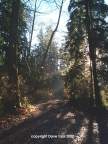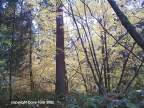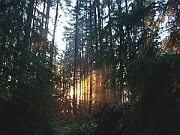
Web page samples | Network Information | Website Design | Repair | About Perpetual PC's | Contact Us | home
At the bottom of this page are some pictures of portions Washington State non public protected forest that were taken in the late fall of 2002. You may copy these pictures and use them for non-commercial content. If you intend to publish them as part of your work we request that you include the copyright information on the pictures. These are samples. They load fast. The large pictures will take a long time to load if you have a dial-up connection. Click on the small pictures for the larger version.
The trees in these pictures are in what we define as a mature forest, being 100 years old. The word "mature" is misleading. All this really means is that most of the obvious evidence of the destruction of 100 years ago is not visible to the average person. The large fir tree in the middle picture is only about 3 feet in diameter at the largest point, and about 95 feet tall. The trees in this forest are very young. If allowed to grow to maximum age, they would be between 700 and 1000 years old and close to 200 feet high. This likely will not happen for several reasons. First, the environment has been altered in such a way as never before; so we have no way of knowing if these trees and this forest will make it that long. Second, the so called civilization surrounding this small piece of forest will soon take over. There are still a few areas like this here, but they are rapidly disappearing. Twenty five years ago there was more than twice as much forest in this area as there is now. If the current trends continue, this small island of nature will be destroyed many years before it becomes what is referred to as an old growth forest.
Unless they study old pictures, most people living in this area can not know the extent of damage that was done by the late 19th and early 20th century; and quite frankly, judging by the actions of those around us, most still do not care. Thousands of acres of trees that were 6 to 8 feet ( and larger ) in diameter and hundreds of years old were wiped out in a period of less that 50 years. How do I know this? For one thing I have studied the remains of what used to be here on this piece of land. There are some stumps that are, after a fire and some decay, still close to 8 feet in diameter. I have lived in this area in or near forested pieces of land for 55 years and have been observing and making mental notes of what I have seen for the last 40 years. The thing that stands out most is the large number of huge (mostly cedar) stumps I have seen. I have traveled from Everett Washington to Bellingham and east to Mount Kulshan, and many points in between and hiked on numerous forested areas and the common denominator is cedar stumps with springboard holes in them. A springboard was a large plank that the loggers stood on to cut down a tree. It was wedged in the side of the large trees by cutting a hole in the side up about 4 to 6 feet from the ground. This lets you know the tree was taken by the hand of man and not nature. After 40 years of making these observations I found confirmation of my suspicions by reading through a book by William Whitfield: History of Snohomish County Washington, Volume 1. Pioneer Historical Publishing Company, Chicago, Seattle 1926. This book has many pictures of the destruction in progress. From the information in this book one can surmise that the destruction consisted of more than thousands of acres. If you happen to read this book you will see that I am being very conservative in my description of what was done to this land and the people who lived here for thousands of years. The destruction of the forest was only part, and in my opinion, the least of the destruction.
We will not be able to replace these ancient trees for perhaps 14 of 15 generations ( about 750 years ) Is there any hope? Possibly. That is why these pictures are here. Enjoy them. We have been caretakers here for over a quarter of a century. We believe others might be interested; if for no other reason, just to know what our creator put here.
Update 2004-09-25: About 2 years after most of these pictures were taken I have observed 2 of the largest hemlock trees in our forest starting to show signs of extreme stress. This is due in my opinion, mainly to abnormally hot dry summer weather the past 2 years.Usually when trees this large ( 2.5 - 3.5 feet in diameter ) "show" signs of extreme stress -- brown needles, drooping foilage ( and yes I know hemlock trees have drooping limbs I have been observing them for 35 years ), they are already dead.How do I know this? I have observed trees, watched them change and die, and talked with experts about my observations. There is also a section of the forest approximately 1/2 acre in area consisting of mostly hemlock trees that have died. In early spring a "freak" windstorm ripped an 18 inch diameter 60+ foot tall hemlock up by the roots, snapped a 20 inch diameter alder tree in half and blew it 40 feet and ripped a 14 inch diameter 75 foot section of a large big leaf maple tree off of the 5 foot diameter portion of its base. More later.....
What is it like to live in a forest? Read this,understand it; and you will know more.Here are some of the observations I have made here in the last 29 years. This should be a wake up call for most people.
images made with
 powered by
powered by  Linux is a registered
trademark of Linus Torvalds
Linux is a registered
trademark of Linus Torvalds




